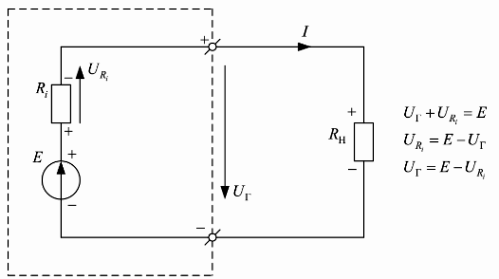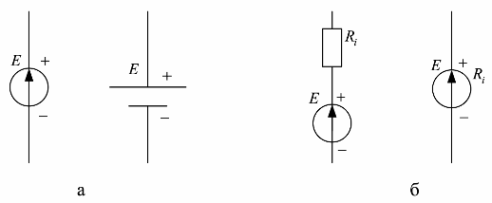What is electromotive force EMF
 Electromotive force (EMF) - in a device that performs a forced separation of positive and negative charges (generator), the value numerically equal to the potential difference between the terminals of the generator in the absence of current in its circuit is measured in volts.
Electromotive force (EMF) - in a device that performs a forced separation of positive and negative charges (generator), the value numerically equal to the potential difference between the terminals of the generator in the absence of current in its circuit is measured in volts.
Sources of electromagnetic energy (generators) — devices that convert energy of any non-electric type into electrical. Such sources, for example, satsa:
-
generators in power plants (thermal, wind, nuclear, hydroelectric), which convert mechanical energy into electrical energy;
-
galvanic cells (batteries) and accumulators of all types, which convert chemical energy into electrical energy, etc.
EMF is numerically equal to the work done by external forces in moving a unit positive charge inside the source or the source itself conducting a unit positive charge in a closed circuit.
Electromotive force EMF E is a scalar quantity that characterizes the ability of an external field and an induced electric field to induce an electric current.The emf E is numerically equal to the work (energy) W in joules (J) expended by this field to move a unit charge (1 C) from one point on the field to another.
The unit of measurement for EMF is the volt (V). Thus, the emf is equal to 1 V if, when a charge of 1 C moves through a closed circuit, work of 1 J is done: [E] = I J / 1 C = 1 V.
Transfer fees through the site electrical circuit accompanied by energy expenditure.
A value whose digit is equal to the work that the source does by conducting a single positive charge along a given section of the circuit is called voltage U. Since the circuit consists of external and internal sections, they distinguish the concepts of voltages of the external Uvsh and internal Uvt sections.
From what has been said, it is obvious that the EMF of the source is equal to the sum of the voltages of the external U and internal U sections of the circuit:
E = Uears + UW
This formula expresses the law of conservation of energy for an electrical circuit.
It is possible to measure voltages in different parts of the circuit only with the circuit closed. The EMF is measured between the open circuit source terminals.

Voltage, EMF and voltage drop for an active two-terminal network
EMF direction — this is the direction of the forced movement of positive charges inside the generator from minus to plus under the influence of a nature other than electrical.
The internal resistance of the generator is the resistance of the structural elements in it.
An ideal source of EMF — a generator, internal resistance which is zero, and the voltage across its terminals is independent of the load. The power of an ideal EMF source is infinite.
A conditional image (electrical diagram) of an ideal EMF generator with a value of E is shown in Fig.1, a.
The real EMF source, unlike the ideal one, contains an internal resistance Ri and its voltage depends on the load (Fig. 1., b), and the power of the source is finite. The electrical circuit of a real EMF generator is a series connection of an ideal EMF generator E and its internal resistance Ri.

EMF sources: a — ideal; b — real
In practice, in order to bring the operating mode of the real EMF generator closer to the ideal operating mode, the internal resistance of the real generator Ri is tried to be as small as possible, and the load resistance Rn needs to be connected at least 10 times the value of the internal resistance of the generator, i.e. it is necessary to fulfill the condition: Rn >> Ri
In order for the output voltage of a real EMF generator to be independent of the load, it is stabilized by using special electronic voltage stabilization circuits.
Since the internal resistance of a real EMF generator cannot be made infinitely small, it is minimized and performed as a standard for the possibility of coordinated connection of energy consumers to it. In radio engineering, the standard output resistance values of EMF generators are 50 ohms (industrial standard) and 75 ohms (home standard).
For example, all television receivers have an input impedance of 75 ohms and are connected to the antennas with coaxial cable of exactly that characteristic impedance.
In order to approximate the ideal EMF generators, the supply voltage sources used in all industrial and household electronic equipment are made using special electronic circuits for stabilizing the output voltage, which allow to withstand an almost constant output voltage of the power source in a given range of currents drawn by the EMF source (sometimes called a voltage source).
On the electrical diagrams, the sources of EMF are depicted as follows: E — a source of constant EMF, e (t) is a source of harmonic (variable) EMF in the form of a function of time.
The electromotive force E of a battery of identical cells connected in series is equal to the electromotive force of one cell E multiplied by the number of elements n of the battery: E = nE.
See also on this topic: Sources of EMF and current: main characteristics and differences
